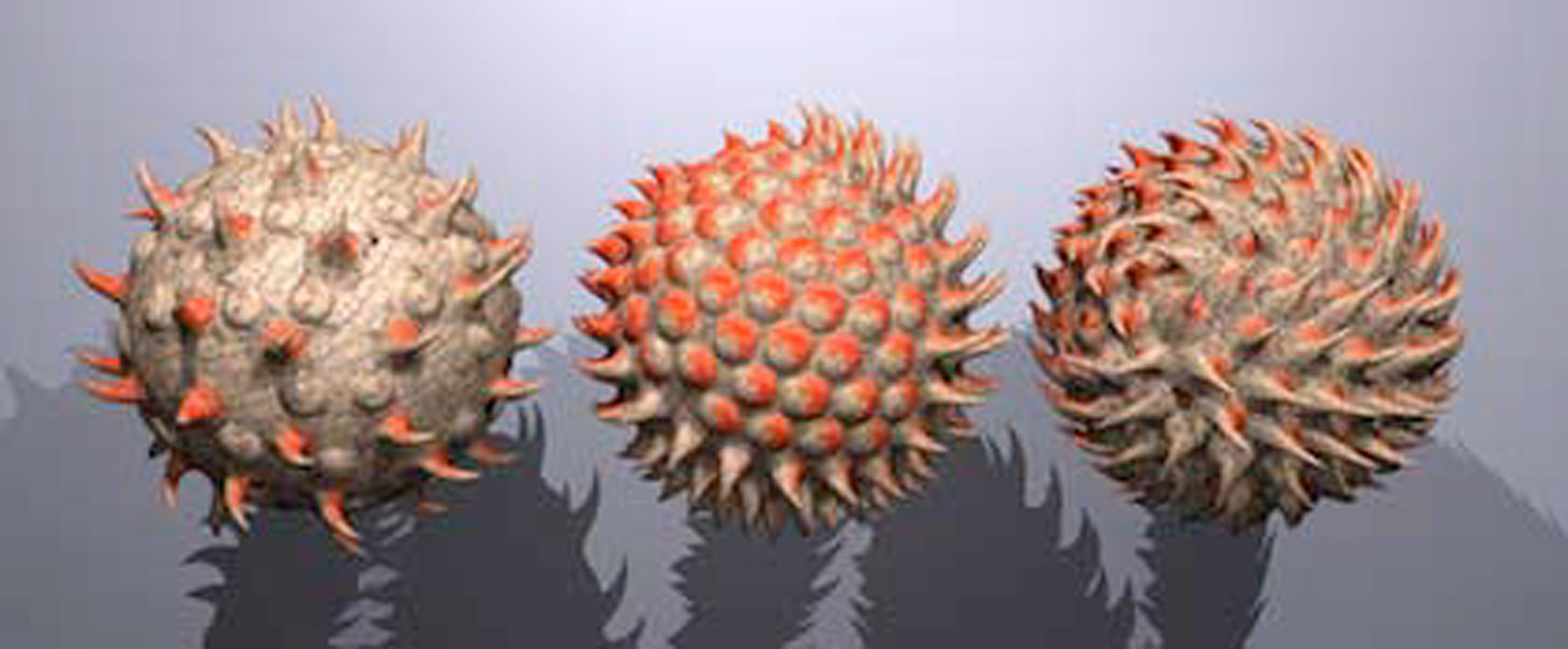“Cellular texture generation” by Fleischer, Laidlaw, Currin and Barr
Conference:
Type(s):
Title:
- Cellular texture generation
Presenter(s)/Author(s):
Abstract:
We propose an approach for modeling surface details such as scales, feathers, or thorns. These types of cellular textures require a representation with more detail than texture-mapping but are inconvenient to model with hand-crafted geometry. We generate patterns of geometric elements using a biologically-motivated cellular development simulation together with a constraint to keep the cells on a surface. The surface may be defined by an implicit function, a volume dataset, or a polygonal mesh. Our simulation combines and extends previous work in developmental models and constrained particle systems.
References:
1. James Arvo and David Kirk. Modeling plants with environmentsensitive automata. In Proceedings of Ausgraph ’88, pages 27-33, 1988.
2. Ronen Barzel. Physically-Based Modeling: A Structured Approach. Academic Press, Cambridge, MA, 1992.
3. Robert L. Cook. Shade trees. In Computer Graphics(SIGGRAPH ’84 Proceedings), volume 18, pages 223-231, July 1984.
4. E C. Crow. A more flexible image generation environment. In Computer Graphics (SIGGRAPH ’82 Proceedings), volume 16, pages 9- 18, July 1982.
5. Jody Duncan. The making of a rockbuster. Cinefex: the Journal of Cinematic Illusions, 58:34-65, June 1994.
6. Kurt Fleischer. Cells: Simulations of multicellular development. In Siggraph Video Review, 1994. A video presented at Siggraph 94.
7. Kurt W. Fleischer. A Multiple-Mechanism Developmental Model for Defining Self-Organizing Structures. PhD dissertation, Caltech, Department of Computation and Neural Systems, June 1995.
8. Kurt W. Fleischer and Alan H. Bart. A simulation testbed for the study of multicellular development: The multiple mechanisms of morphogenesis. In Artificial Life III. Addison-Wesley, 1994.
9. Deborah R. Fowler, Hans Meinhardt, and Przemyslaw Prusinkiewicz. Modeling seashells. In Computer Graphics (SIGGRAPH ’92 Proceedings), volume 26, pages 379-388, July 1992.
10. Deborah R. Fowler, Przemyslaw Prusinkiewicz, and Johannes Battjes. A collision-based model of spiral phyllotaxis. In Computer Graphics (SIGGRAPH ’92 Proceedings), volume 26, pages 361-368, July 1992.
11. C.W. Gear. Numerical Initial Value Problems in Ordinary Differential Equations. Prentice-Hall, Englewood Cliffs, NJ, 1971.
12. Goldstein. Classical Mechanics. Addison-Wesley, 1980.
13. Ned Greene. Voxel space automata: Modeling with stochastic growth processes in voxel space. In Computer Graphics (SIGGRAPH ’89 Proceedings), volume 23, pages 175-184, July 1989.
14. James T. Kajiya. Anisotropic reflection models. In Computer Graphics (SIGGRAPH ’85 Proceedings), volume 19, pages 15-21, July 1985.
15. James T. Kajiya and Timothy L. Kay. Rendering fur with three dimensional textures. In Computer Graphics (SIGGRAPH ’89 Proceedings), volume 23, pages 271-280, July 1989.
16. Hans Meinhardt. Models of Biological Pattern Formation. Academic Press, London, 1982.
17. Gavin Miller and Andrew Pearce. Globular dynamics: A connected particle system for animating viscous fluids. Computers and Graphics, 13(3):305-309,1989.
18. J.D. Murray. MathematicalBiology. Springer-Verlag, New York, 2nd edition, 1993.
19. B. N. Nagorcka, V. S. Manoranjan, and J. D. Murray. Complex spatial patterns from tissue interactions – an illustrative model. Journal of Theoretical Biology, 128:359-374, 1987.
20. Garrett M. Odell, George Oster, R Alberch, and B. Burnside. The mechanical basis of morphogenesis. DevelopmentalBiology, 85, 1981.
21. Hans Kohling Pedersen. Displacement mapping using flow fields. In Proceedings of SIGGRAPH ’94 (Orlando, Florida, July 24-29,1994), pages 279-286. ACM Press, July 1994.
22. John Platt. Constraint Methods for Neural Networks and Computer Graphics. PhD dissertation, Caltech, Department of Computer Science, Pasadena, CA, 91125, 1989.
23. Przemyslaw Prusinkiewicz, Mark James, and Radomi( M6ch. Synthetic topiary. In Proceedings of SIGGRAPH ’94 (Orlando, Florida, July 24-29,1994), pages 351-358. ACM Press, July 1994.
24. Przemyslaw Prusinkiewicz and Aristid Lindenmayer. The Algorithmic Beauty ofPlants. Springer-Verlag, New York, 1990.
25. W. T. Reeves. Particle systems – a technique for modeling a class of fuzzy objects. ACM Trans. Graphics, 2:91-108,April 1983.
26. William T. Reeves and Ricki Blau. Approximate and probabilistic algorithms for shading and rendering structured particle systems. In Computer Graphics (SIGGRAPH ’85 Proceedings), volume 19, pages 313-322, July 1985.
27. Craig W. Reynolds. Flocks, herds, and schools: A distributed behavioral model. In Computer Graphics (SIGGRAPH ’87 Proceedings), volume 21, pages 25-34, July 1987.
28. Karl Sims. Particle animation and rendering using data parallel computation. In Computer Graphics (SIGGRAPH ’90 Proceedings), volume 24, pages 405-413, August 1990.
29. Karl Sims. Artificial evolution for computer graphics. In Computer Graphics (SIGGRAPH ’91 Proceedings), volume 25, pages 319-328, July 1991.
30. Alvy Ray Smith. Plants, fractals and formal languages. In Computer Graphics (SIGGRAPH ’84 Proceedings), volume 18, pages 1-10, July 1984.
31. John Snyder. Generative Modeling for Computer Graphics and CAD: Symbolic Shape Design using Interval Analysis. Academic Press, 1992.
32. John M. Snyder and Alan H. Bart. Ray tracing complex models containing surface tessellations. In Computer Graphics (SIGGRAPH ’87 Proceedings), volume 21, pages 119-128, July 1987.
33. Richard Szeliski and David Tonnesen. Surface modeling with oriented particle systems. In Computer Graphics (SIGGRAPH ’92 Proceedings), volume 26, pages 185-194, July 1992.
34. Demetri Terzopoulos, John Platt, and Kurt Fleischer. From goop to glop: Heating and melting deformable models. In Graphics Interface 89, 1989.
35. Alan Turing. The chemical basis of morphogenesis. Phil. Trans. B., 237, 1952.
36. Greg Turk. Generating textures for arbitrary surfaces using reactiondiffusion. In Computer Graphics (SIGGRAPH ’91 Proceedings), volume 25, pages 289-298, July 1991.
37. Greg Turk. Re-tiling polygonal surfaces. In Computer Graphics (SIGGRAPH ’92 Proceedings), volume 26, pages 55-64, July 1992.
38. Stephen H. Westin, James R. Arvo, and Kenneth E. Torrance. Predicting reflectance functions from complex surfaces. In Computer Graphics (SIGGRAPH ’92 Proceedings), volume 26, pages 255-264, July 1992.
39. Andrew Witkin, Kurt Fleischer, and Alan Bart. Energy constraints on parameterized models. In Computer Graphics (SIGGRAPH ’87 Proceedings), volume 21, pages 225-232, July 1987.
40. Andrew Witkin and Michael Kass. Reaction-diffusion textures. In Computer Graphics (SIGGRAPH ’91 Proceedings), volume 25, pages 299-308, July 1991.
41. Andrew R Witkin and Paul S. Heckbert. Using particles to sample and control implicit surfaces. In Proceedings of SIGGRAPH ’94 (Orlando, Florida, July 24-29,1994), pages 269-278. ACM Press, July 1994.





